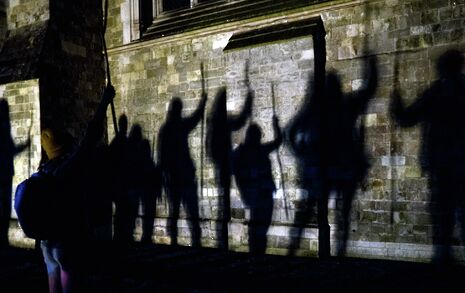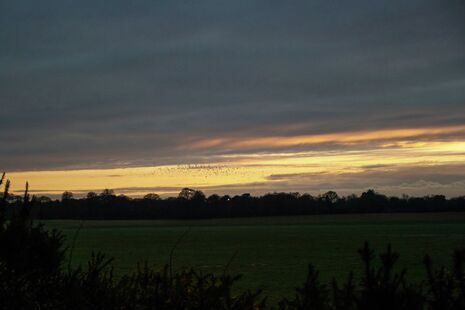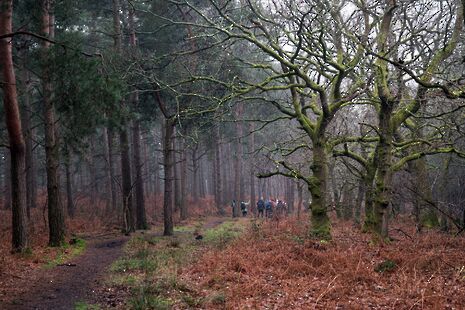Long Read: Modern-day pilgrimage, and why it matters
Alice Attlee goes on pilgrimage with The British Pilgrimage Trust, and reflects on the practice’s potential for promoting religious tolerance, ecological awareness, and health of all kinds

On Saturday 11th March, I stood with my forehead and hands pressed against the east wall of St. Bart’s Church, Haslemere. To my left and my right, complete strangers made the same action, touching skin to stone in a long silence. Pushing my palms against the grey, lichened surface of the wall, I turned to join a circle of people – more strangers – who were gathered together next to the old Yew Tree that stood in the church’s graveyard. A few further rituals, an old song sung, and we would all begin the journey that would take us from Haslemere, to Easebourne, and, finally, Chichester. Led by the founders of The British Pilgrimage Trust, Will Parsons and Dr Guy Hayward, we would cover about 25 miles in two days at a steady walking pace: well led, well fed and with plenty of rests along the way.
Going on a pilgrimage is easy. Writing about it – less so. ‘Pilgrimage’ is an ancient term and an even older concept, with difficult words like ‘holy places’ and ‘religion’ rolled up inside of it. As the group of us weekend walkers – pilgrims, as we began to feel – gathered together in that first circle, Will and Guy introduced those tricky words for us to think about for ourselves. A pilgrimage, they explained, is a journey on foot. Put one foot in front of the other, make a journey between one holy place and another, and you’ve got yourself a pilgrimage.
As for the holy places, Will and Guy continued, they can be whatever you want them to be – special places towards which you feel compelled to walk. Such places give your steps a purpose, something to focus on as you walk. When you arrive at one, they provide space for contemplation, rest, and respite before you head off towards the next, or end your pilgrimage. The word ‘holy’ derives from the Old English word ‘halig’, which translates as ‘healthy’, ‘wholesome’, or ‘holistic’. A holy place, then, is one in which you feel yourself to be experiencing these things, a place in which you find, for whatever reason, a sense of wellbeing. If you visit the website, it will explain to you this same thing, concluding: “Holy does not imply particular religious allegiance.”
These were questions that remained, and still remain, open to all who chose to join that pilgrimage through the West Sussex countryside
Many of the traditional holy places of Britain are Christian in their origins – churches, chapels and the like. This makes sense, since the land’s most widespread religion for over a thousand years has been Christianity. It is deep-rooted in the landscapes of Britain: walk on an old pilgrim path and lose your way, and before too long you’ll sight a church spire to walk towards from which to get your bearings. Find yourself running low on water, and the spring you find to quench your thirst (you’d be wise to have a good filter) will probably have been blessed by pilgrims, religious officials, or both. This is an important aspect of the British pilgrimaging tradition, and one welcomed by The British Pilgrimage Trust (we met in a churchyard, after all) – but it is by no means the only way to access the sense of wellbeing that can be gained from pilgrimage.

On the second day of walking, standing in another churchyard and encircling another yew tree, Guy explained that often in such places such a tree would have taken root long before the church did. Yews have astonishingly long lives: one of the oldest documented in Britain is estimated to have begun its life in Defynnog, Breconshire, at least 5,000 years ago, predating Christianity altogether. Their capacity for longevity and regeneration (they continue to grow new shoots from the base of their trunks well into their old age) made them symbols of death and resurrection for the people of Britain well before Christianity became the nation’s predominant religion.
To travel between yew trees is to acknowledge that there are things that outlast us. A 5,000-year-old tree will have borne witness to countless generations of human lives. At a very basic level, they are simply something bigger than us, something that reaches towards the sky and is rooted in the earth. This is not to underplay the importance of yews to Christian faith in Britain: yew shoots are often buried with the dead in churchyards, and their boughs are used as ‘palms’ in churches at Easter. But their history is an invitation to all pilgrims of all creeds: they are one of the many examples of how holy places can represent different things to different people. As Will and Guy would tell us over and again throughout the weekend, a pilgrimage, a holy place, is whatever you want it to be.
Over the course of those two days of walking, it was clear that this insistence on inclusivity was more than words, more than an ideal. It simply is what you feel through partaking in pilgrimage. The British Pilgrimage Trust has a “bring your own beliefs” policy, and I soon learnt that many of my fellow pilgrims had done just that: there were numerous variants of numerous faiths among our group. Many, like myself, had simply brought with them a belief in the power of walking, of meeting new people, and in the sense of wellbeing that can be found in walking through a new landscape at the turn of the seasons.

The motivations for each pilgrim’s walk were different. Some were making the most of the freedom and energy they had found upon retirement, some were taking time to reflect on their nine-to-fives and families, a few were preparing for a much longer pilgrimage from Canterbury to Jerusalem. There were as many reasons for and perspectives on pilgrimage as there were pilgrims. Walking together, or taking steps apart, we considered what pilgrimage meant for us, for each other, and, tentatively, what it might be able to achieve on a wider scale.
These were questions that remained, and still remain, open to all who chose to join that pilgrimage through the West Sussex countryside – and for all who choose to venture out into the world as pilgrims. They are questions to which the answers are more easily felt than articulated. As the dusk settled on Sunday evening and we reached our final destination of Chichester Cathedral, we gathered in our final circle, no longer flanked by strangers but by fellow pilgrims.
Over two days of walking, we had revelled in our differences and marvelled at the unexpected things that had affected us in similar ways. With each person I fell into step with, I experienced their tolerance and, even better, their curiosity and openness towards the ideologies and beliefs held by each pilgrim. We had bought each other pints and sung together in churches, told each other our secrets and fought together with sticks. United in the journey, we left with more questions opened up than answered, but with a firm belief, however difficult to pin down, in the holy, healthy power of pilgrimage
 Features / Should I stay or should I go? Cambridge students and alumni reflect on how their memories stay with them15 December 2025
Features / Should I stay or should I go? Cambridge students and alumni reflect on how their memories stay with them15 December 2025 News / Cambridge study finds students learn better with notes than AI13 December 2025
News / Cambridge study finds students learn better with notes than AI13 December 2025 Comment / The magic of an eight-week term15 December 2025
Comment / The magic of an eight-week term15 December 2025 News / News In Brief: Michaelmas marriages, monogamous mammals, and messaging manipulation15 December 2025
News / News In Brief: Michaelmas marriages, monogamous mammals, and messaging manipulation15 December 2025 News / Uni Scout and Guide Club affirms trans inclusion 12 December 2025
News / Uni Scout and Guide Club affirms trans inclusion 12 December 2025









